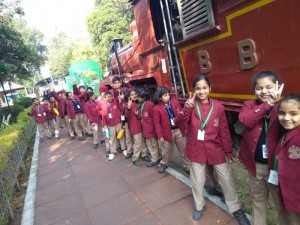Class 3 Visit to the National Rail Museum
Experiential learning develops curiosity among students and helps them to acquire a better understanding of the what is taught in the classroom. Trips and excursions complement textbook learning and are a welcome treat for the young ones.
To satiate the inquisitive young minds, students of class 3 were taken on a tour of the iconic National Rail Museum, situated in Chanakyapuri on 29 January 2020. The 133 students were accompanied by five vigilant teachers who kept the lively group engaged about trains and engines.
Set amidst a well landscaped terrain, the museum showcases the rich heritage of the Indian Railways. The exhibits unfold the great and illustrious journey of the Indian Railways from the antique steam engines to the more recently used diesel and electric locomotives. A fascinating collection of wagons, carriages and rail cars along with a lot of artifacts related to the railways such as different types of signaling equipment, telecommunication systems, antique railway furniture etc., fascinated the millennial generation of students.
The excited group could barely contain its excitement at the outdoor section of the rail garden which houses facsimiles of trains passing through various terrains of India and famous stations such as the Lucknow Junction, Chhatrapati Shivaji Terminal etc.
[gallery link="file" order="DESC"]
The ride on the toy train was a penultimate expression of sheer delight and joyous abandon as the tiny train chugged its way through a dark tunnel. Thereafter, the explorers descended on the indoor museum to view the displays of the famous Patiala State Monorail Trainways, the Fairy Queen, the Morris Fire Engine, the vintage electric locomotives such as the Sir Leslie Wilson and the Kalka-Shimla Railbus. The section on Miniature India, located on the first floor of the indoor museum, was the most interesting.
The visit was both informative and invigorating as the students, born in the age of the Metro, were able to gain an insight into the fascinating evolution of the Great Indian Railways.
For more pictures...click here













